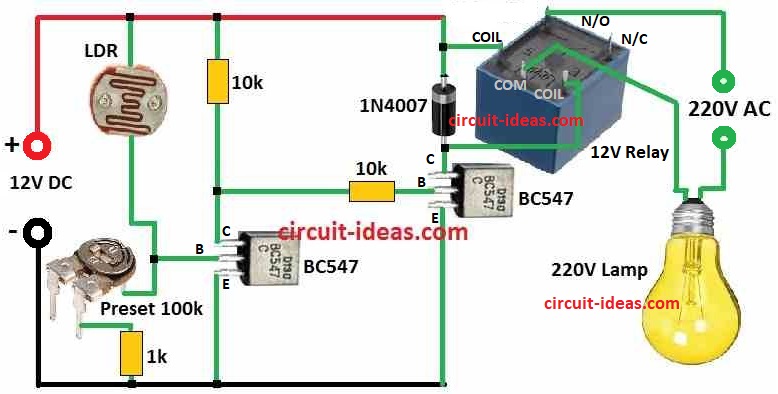Saving electricity is very important and mostly in city where power is not enough.
This article for Automatic Day Night Switch Circuit show how to make easy auto light switch.
It turn ON or OFF light when outside light changes.
This way people can save money on electric bill.
What is a Automatic Day Night Switch Circuit:
Automatic Day Night Switch Circuit is also called light sensor switch or evening light switch which is made to turn ON light at night or when dark and turn OFF in day or when bright.
Outside lights, streetlight, and other things need auto light control based on outside light.
And this circuit is mostly designed for that.
Circuit Working:

Parts List:
| Type | Specification | Quantity |
|---|---|---|
| Resistors | 10k | 2 |
| 1k | 1 | |
| LDR | 1 | |
| Preset 100k | 1 | |
| Semiconductors | Transistor BC547 | 2 |
| Diode 1N4007 | 1 | |
| Relay 12V | 1 |
This circuit uses two transistors Q1 and Q2 and one LDR.
When light come on LDR its resistance goes up and Q1 turn ON so relay also turn ON.
When there is no light Q1 turn OFF and relay also goes OFF.
This way circuit switches things automatic which is good to control lights in day and night.
Using this simple day night circuit can help save electricity and also helps solve todays energy problem in small way
Formulas:
Below is formula for Automatic Day Night Switch Circuit:
LDR (Light Sensor) Resistance:
RLDR ∝ 1 / ILDR
where:
- RLDR is the resistance of LDR
- ILDR is the current going through LDR
Transistor Q1 Turn ON Voltage:
VT1 = VBE1 + ILDR × RLDR
where:
- VT1 is the voltage needed to turn ON Q1
- VBE1 is the base to emitter voltage of Q1
Transistor Q2 Turn ON Voltage:
VT2 = VBE2 + (VCC − ILDR × RLDR)
where:
- VT2 is the voltage needed to turn ON Q2
- VBE2 is the base to emitter voltage of Q2
- VCC is the supply voltage
Relay Turn ON Time:
τ = RRelay × CRelay
where:
- RRelay is the resistance of relay coil
- CRelay is the capacitor with relay
Note:
These formula show how resistance, current and voltage work in this circuit.
With the help of this simple auto day night switch circuit we can make it easily.
How to Build:
Follow the below mentioned steps for building a Automatic Day Night Switch Circuit:
- First collect all parts and keep on clean table.
- When picking resistors, capacitors, diodes check they match circuit values.
- Connect LDR with the circuit.
- Q1 and Q2 change ON/OFF because LDR resistance change when light changes.
- Use NPN transistors for Q1 and Q2.
- In daytime Q1 turn ON and make relay work and at night Q2 turn ON and take control.
- Check relay is connected to correct transistor.
- This setup help to turn ON/OFF light or other things in day and night.
- We can use 100k variable resistor to adjust how sensitive circuit is.
- This help circuit to work better in different places.
- Use 5V to 12V DC battery but be sure voltage matches with relay specifications.
References:
DESIGN AND CONSTRUCTION OF AN LDR
Leave a Reply